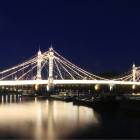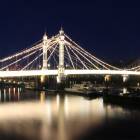Albert Bridge. The elegant bridge of London
It’s clearly not as iconic as the Tower Bridge, with its hydraulic flipping deck, nor does it have the impressive scenery of the City behind, like other crossing points have, but Albert Bridge can stand out through its own aspect alone. Well, at least two other bridges in the capital share a similar architecture (Chelsea and Hammersmith, one upstream and one downstream on the river), but the royal sounding bridge has bigger and brighter white cables hanging from the two pillars, making it more picturesque.
A little bit of history about bridges
This bridge was improved during its long existence of a century and a half, employing different methods, which gives us the opportunity to look back on how technology morphed. From antiquity, humans have expanded the simple idea of connecting two very close banks of a narrow river with what was initially a wood plank. In order for this deck to be extended in width and length, pillars were added underneath, including inside the water. Which was problematic in faster running and deeper rivers. The crossings got better and more impressive, but the principle remained the same: you wanted it to be longer, you had to build sturdier and more numerous pillars underneath from place to place. Which is a costly method and it blocks the naval traffic for bigger boats underneath.
With this simple design, called cantilever bridge, the Romans were able to build impressive structures like viaducts and aqueducts over steep dry valleys. But also the biggest bridge ever built in antiquity, the bridge over Danube, that emperor Trajan commissioned Apolodorus of Damascus in order to invade Dacia. These structures used also another key architectural feature of that age: the Roman arch, used to support all sorts of structures on walls and columns, by dissipating load forces.
In the Middle Ages, a Venetian, Fausto Veranzio, came up with a revolutionary idea in 1595. He imagined a bridge that had two high pillars on each bank, from which heavy chains were hung, holding the wooden deck on which people would pass. The idea used probably other features used before, such as the retractable bridge over the moats of fortresses or the rope used as hand railings, that give stability to small footbridges. The idea was brilliant, but it started to be widely used only after over two hundred years, in the 19 century.
Very soon, the chains were replaced by more powerful steel cables. And the initial design modified, moving the pair of towers from the banks closer to the middle of the river. This was how the cable-stayed bridge was born. And it became the norm for advanced countries during the 19th century. The position of the pillars and of the cables was also tinkered with, most builders agreeing that best results could be obtained using high pillars at about a quarter or a third to each end. And with cables hanging from somewhere close to the top of those pillars, hanging on the deck from point to point, creating also a nice fan-like design of rays coming down from the top of the pillars.
In 1801, in Pennsylvania, inventor James Finley used another idea that was a significant step forward. Instead of using many long chains or cables coming down from the top of the pillars to points on the deck, he used such chains only for the extremities of the bridge (producing a letter A shape). From these support cables he hung vertical cables supporting the deck from point to point. The suspension bridge was thus born. A superior method that was eventually to replace the previous, at least for bridges that need a longer distance. It is to this day, the method used for the longest bridges in the world.
A beautiful failure
Albert Bridge in London can be considered a transition form between the two systems of cable-stayed and suspension bridge. Built in 1873 by Rowland Mason Ordish, it used an original method called „Ordish-Lefeuvre system”. The method uses both rays of cables, like in a cable-stayed bridge, but also vertical wrought iron rods to support the deck. Rowland Ordish and William Le Feuvre wanted to use their patent for this London bridge first. But due to bureaucracy, works were delayed, so they had time to build a similar bridge in Prague first. That Frank Josef bridge was in the meantime demolished, leaving Albert Bridge as the only one in the world using this original system.
However creative, the method could not foresee the increase in traffic in the 20th century. Especially, the crossing of heavy military vehicles and troops during world war two took a high toll on the structural safety of the bridge. Which to this day has a plate warning that „all troops must break step when marching on this bridge”. So in 1973, Albert Bridge underwent a consolidation project that turned it more into a modern day suspended bridge.
We could say Albert Bridge was a failure in all respects. As an engineer work, it soon needed structural interventions. Just 11 years after the inauguration in 1873, the bridge started to receive enforcement works. The iron rods were replaced by cables, turning it more into a standard suspension bridge. Even so, it soon had to have traffic restrictions for vehicles over two tons. More drastic proposals were made, from demolishing it altogether to turning it into a pedestrian only footbridge, because the locals were found of it. Remaking the most of it was the solution that prevailed.
Financially it was also a lost cause. Initially, it was supposed to be a profitable endeavor, hence the tax booths, still visible today. The project affected another tax bridge over Thames, Battersea Bridge, which the company was forced by law to buy. Eventually the practice of paying for crossing the river was completely dropped in London. But the booths remain in place as a souvenir, now more valuable because they are the only such booths still visible in the city.
However, the 220 m bridge, 12 m wide, is a representative image for London. And is one of the few significant landmarks by which Rowland Mason Ordish left his mark on London. The other significant works being the Holborn Viaduct and the dome of Royal Albert Hall.
Mai multe despre: Architecture, UK • Albert bridge • bridge • London • prince Albert • Rowland Mason Ordish
- Home Page
start page - Architecture
landmark buildings - Sacred architecture
places of worship - Nature
landscape photography - Concert
performing artists - Christmas
Santa Claus pictures
- Jooble
jobs for photographers - Escape
an out of control blog - Merry Christmas
The best organizer of Christmas parties - Astro photo
Eclipse hunting and astrological photography












